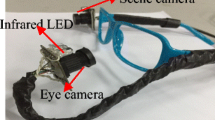Abstract
We present how gaze detection can be used to enhance the Rapid Serial Visual Presentation (RSVP) format, a dynamic text presentation technique suitable for mobile devices. A camera mounted on the device is used to monitor the reader’s gaze and control the onset of the text presentation accordingly. The underlying assumptions for the technique are presented together with a description of a prototype, Smart Bailando, as well as our directions for further work.
Access this chapter
Tax calculation will be finalised at checkout
Purchases are for personal use only
Preview
Unable to display preview. Download preview PDF.
Similar content being viewed by others
References
Bruijn, O. and Spence, R. (2000). Rapid Serial Visual Presentation: A space-time trade-off in information presentation. Proceedings of Advanced Visual Interfaces, AVI’2000.
Castelhano, M.S. and Muter, P. (2001). Optimizing the reading of electronic text using rapid serial visual presentation. Behavior & Information Technology, 2001, 20(4), 237–247.
Duchnicky, R.L. and Kolers, P.A. (1983). Readability of text scrolled on visual display terminals as a function of window size. Human Factors, 25, 683–692.
Goldstein, M., Sicheritz, K. and Anneroth, M. (2001). Reading from a small display using the RSVP technique, Nordic Radio Symposium, NRS01, Poster session, Nynäshamn, 4–6 April 2001 (full paper available on CD-Rom only).
Goldstein, M., Öquist, G., Bayat-M., M., Björk, S. and Ljungberg, P. (2001). Enhancing the reading experience: Using Adaptive and Sonified RSVP for reading on small displays, Proceedings of 3 rd International Mobile HCI Workshop.
Goldstein, M., Öquist, G. and Björk, S. (2002). Immersion does not guarantee Excitement: Evaluating Sonified RSVP (Full paper submitted to NordiCHI’2002).
Just, M.A. och Carpenter, P.A. (1980). A theory of reading: From eye fixations to comprehension, Psychological Review, 87(4), 329–352.
Joula, J.F., Ward, N.J. and MacNamara, T. (1982). Visual search and reading of rapid serial presentations of letter strings, words and text. J. Exper. Psychol.: General, 111, 208–227.
Kump, P. (1999). Break-trough rapid reading. New Jersey: Prentice-Hall Press.
Mills, C.B. och Weldon, L.J. (1987). Reading text from computer screens. ACM Computing Surveys, Vol. 19, No. 4, ACM Press.
Muter, P. (1996). Interface design and optimization of reading of continuous text. In van Oostendorp, H. & de Mul, S. (Eds.), Cognitive aspects of electronic text processing, 161–180. Norwood, N.J.: Ablex.
Muter, P. and Maurutto, P.(1991). Reading and skimming from computer screens and books: The paperless office revisited? Behavior & Information Technology, 10, 257–266.
Norman, D.A. (1988). The Psychology of Everyday Things. Doubleday, NY, USA.
Rahman, T. and Muter, P. (1999). Designing an interface to optimize reading with small display windows. Human Factors, 1(1), 106–117, Human Factors and Ergonomics Society.
Schilit, B.N., Adams, N. and Want, R. (1994). Context-aware computing applications. Proceedings of the IEEE Workshop on Mobile Computing Systems and Applications.
Åkervall, P. and Granath, R. (2002). Eye Controlled RSVP on Handhelds. Forthcoming Master’s Thesis.
Öquist, G. and Goldstein, M. (2002). Towards an improved readability on mobile devices: Evaluating Adaptive Rapid Serial Visual Presentation. Proceedings of Mobile HCI’2002.
Author information
Authors and Affiliations
Editor information
Editors and Affiliations
Rights and permissions
Copyright information
© 2002 Springer-Verlag Berlin Heidelberg
About this paper
Cite this paper
Öquist, G., Björk, S., Goldstein, M. (2002). Utilizing Gaze Detection to Simulate the Affordances of Paper in the Rapid Serial Visual Presentation Format. In: Paternò, F. (eds) Human Computer Interaction with Mobile Devices. Mobile HCI 2002. Lecture Notes in Computer Science, vol 2411. Springer, Berlin, Heidelberg. https://doi.org/10.1007/3-540-45756-9_43
Download citation
DOI: https://doi.org/10.1007/3-540-45756-9_43
Published:
Publisher Name: Springer, Berlin, Heidelberg
Print ISBN: 978-3-540-44189-2
Online ISBN: 978-3-540-45756-5
eBook Packages: Springer Book Archive




